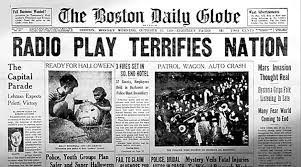RADIO CSP 2 – WAR OF THE WORLDS
So to listen to the original broadcast open up this link below:
https://archive.org/details/OrsonWellesMrBruns
https://en.wikipedia.org/wiki/The_War_of_the_Worlds_(1938_radio_drama)


This is a Targeted Close Study product for which you will need to focus on the following areas of the Theoretical Framework:
> Media Industries
> Media Audiences
You will need to listen to excerpts from the broadcast but the main focus will be the technological development of radio as an institution.
War of the Worlds is an early example of a hybrid radio form, adapting the H.G Welles story using news and documentary conventions. The broadcast and the initial response to it has historical significance as an early, documented, example of the mass media apparently having a direct effect on an audience’s behavior. The academic research carried out into the broadcast (and the ongoing dispute about the extent of the effect) provided some of the early media audience research and the findings have been extremely influential in the media, advertising and political campaigning.
RadioLab: War of the Worlds
Podcast Oct 30th 2018
A useful overview and discussion of the context can be found here (not part of the CSP for assessment):
https://www.wnycstudios.org/story/war-worlds
MICHAEL SOCOLOW: The C.E Hooper ratings survey found 98 percent of the respondents were not listening to Orson Welles or “War of the Worlds.” They were listening to the Chase and Sanborn hour or their radios were off or they were listening to another program. Of the two percent that they found that were listening to “War of the Worlds,” not a single respondent thought it was a news broadcast.
JAD ABUMRAD: Socolow strongly suggests that the panic was actually trumped up by the newspapers who were trying to piss on this new medium called radio that was taking away their, you know, audience.
MICHAEL SOCOLOW: Exactly. Here was the opportunity and radio-the radio industry and the newspaper industry had been battling for years. Throughout that decade, the entire newspaper industry had been losing money, political prestige, and other things to the radio industry, you know, some of their best employees. And so they were waiting for a way to really to prove to advertisers and to federal regulators, you know, they had the first amendment, they understood responsibility-these are the newspaper managers. These radio guys were conflating advertising with programming, they were frightening their viewers, they acting irresponsibly. And remember, this is a month after Munich when radio proved that news really works on the radio. Well, one month after radio news, you know, comes of age, suddenly they’re conflating news accounts with fiction and they’re acting irresponsibly and they’re terrorizing the public and so the newspaper industry had the perfect thing to hang their critique of radio on.
Copycat behaviour . . . this extract from the broadcast refers to another broadcast (word for word) of War of the Worlds broadcast in Ecuador in 1949)
ROBERT KRULWICH: And according to the station manager, people bought it.
ARCHIVE, Kay: Buffalo police and telephone company reported to WKBW that they received more than 4,000 phone calls. The Canadian military authorities dispatched military units to the Peace Bridge, the Rainbow Bridge, and the Queenston Bridge to repel invaders. The story was carried the next day by 47 newspapers countrywide and on the night of the show and during the show united press bureaus up and down the east coast of America were besieged by phone calls asking about the Martian invasion in Buffalo. Incredible? You’re absolutely right, it is incredible.
CONCEPTUAL AREAS
1. Media Institutions
War of the Worlds provides an historical context for broadcasting, being produced at a period when radio was the only form of domestic media; the 1930s and 1940s became known as the ‘golden age’ of radio.
- War of the Worlds was broadcast by Columbia Broadcasting Company – an institution still in existence (in a very different form) today.
- Radio broadcasting was seen as direct competition to newspapers which had previously been the only way of receiving news.
- The broadcast is typical of the way institutions are always looking for new styles in order to attract audiences.
- Regulation – radio broadcasting was regulated by the Federal Communications Commission and it investigated the broadcast to see if it had broken any laws.
- The broadcast provides an excellent example to consider the effect of individual producers on media industries (known as ‘auteur theory’) as this is the work of Orson Welles.
2. Media Audiences
War of the Worlds has become a real-world test case for a variety of audience theories, although the exact nature of the audience response is still disputed.
- What techniques (ie Media Language) does the broadcast use to convince the audience that what they’re hearing is really happening?
- Consider the way that external factors – global political context, gender, religion, education etc. – are likely to also affect audience response
- The ways in which audiences interpret the same media product differently – at the time of broadcast and now (Reception theory including Hall)
- Cultivation theory including Gerbner
3. Historical, political, social and cultural contexts
For many, the wider social, political, historical and cultural contexts are not just clearly connected to media studies but they are in some ways more important.
“I’ve always said you can’t understand the world without the media nor the media without the world”
(Professor Natalie Fenton, quoted in Fake news vs Media Studies J. McDougall p.17 2019, Palgrave)
“I do spend long periods of time with my gaze turned away from the media, because I’m seeking to understand what’s going on out there, and then the role of the media in that context. I’m always putting the social, the political and the economic (contexts) first.” (ibid)
War of the Worlds can be considered in a historical context as it provides an interesting study of the power and influence of radio as a form during its early days of broadcasting. It is also useful to consider the product in a social, cultural and political context when considering audience responses to the programme. It was first broadcast on the eve of World War II and reflected fears of invasion in the US and concerns about international relations.
ROBERT KRULWICH: So, here are two ways to think about the “War of the Worlds.” One: it was a smashing entertainment using every trick they could think of, including inventing some new ones to scare you silly. Master storytelling. Or-or and it was: we’re trying to send you a warning. Don’t trust everything you hear on the radio, it’s not always true.
https://radiolab.org/episodes/war-worlds 52:00
Some other thoughts regarding this text center around contemporary ideas of Fake News. In other words, do we / can we trust the media? Where do you get knowledge and information? It also a text that shows the power of the media, to influence vulnerable audiences. Although I wonder if the stories around audiences reacting passively as if it were a true story were exaggerated almost as a marketing exercise, that in itself is a form of made up information? Indeed, isn’t all information made up? How do we know what is truth? What is clear is that the distinction between fact and fiction is often blurred and relies upon audience members recognising and understanding specific codes and conventions that relate to each Media Language. In this instance, the Language of Radio is used creatively to structure a text that could be taken as fact, but is clearly fiction. Recognising the particular social and historical moment that this media text was produced is significant, so was this a comment on the ability of the mass media to create propaganda and manipulate a compliant and vulnerable mass audience? Is that still relevant today? Think about twitter, Trump, Brexit etc. If so, then Chomsky‘s argument that the media is used by powerful groups – ‘Manufacturing Consent‘ – is the most appropriate theory to structure an understanding of media, technology, control, manipulation and power.
ROBERT KRULWICH: that most people already knew – if he could grab us and if they could do it again in Ecuador and then if they can do it again in Buffalo, what does that tell you? It tells you that we can’t help ourselves. Even if the headline is slightly preposterous, even if it’s slightly scary, even if it’s slightly false, we will listen.
JASON LOVIGLIO: The fear that these broadcasts generate now suck us in and you’d think 70 years later, we’d be more sophisticated and critical when the local newscaster tells us that there’s something we’re feeding our children that could kill them and they’ll tell-we-I still listen. I’m a media critic and I still wade through the commercials to see, what is it that I’m doing to kill my child?
Other areas to think about (but unlikely to form part of your assessment)
Media Language
- War of the Worlds is a good case study for students to understand the way codes and conventions of radio drama (sound, dialogue, SFX, microphone technique, silence, words, accents, dialects etc) are put together to create meaning and construct a recognisable and familiar genre (Steve Neale). War of the Worlds also belongs to the genre of sci-fi and invasion – how are the conventions evident?
- But can War of the Worlds be considered as an intertextual product? Or pastiches of other genres.
- Consider how developing technologies affect media language: in 1938 radio was still a relatively new mass media technology, the broadcast could experiment with the form in a way not possible later on.
- At the time of the broadcast the idea of hybrid genres was unfamiliar, with clear boundaries between fact and fiction, making this a significant development in the form.
- A look at the Language of Radio: https://hautlieucreative.co.uk/media23al/2022/10/26/radio-production/
- This is a post from last year where we looked at the social, cultural, historical and political contexts of media: https://hautlieucreative.co.uk/media21al/2020/02/27/social-political-historical-cultural/
Media Representations
While there are representations of social and cultural groups in War of the Worlds, this broadcast is particularly significant for studying how a media product constructs a representation of reality, drawing on issues in society to convince the audience of its reality.
- How does the use of media language construct the representation of the real?
- Is this programme an early example of fake news?
- What signifiers of different groups and social classes are used?
- The representation of the alien invaders in sci-fi genre.
- As a broadcast in October 1938, can War of the Worlds be interpreted as representing particular political concerns to US – and international – society?

